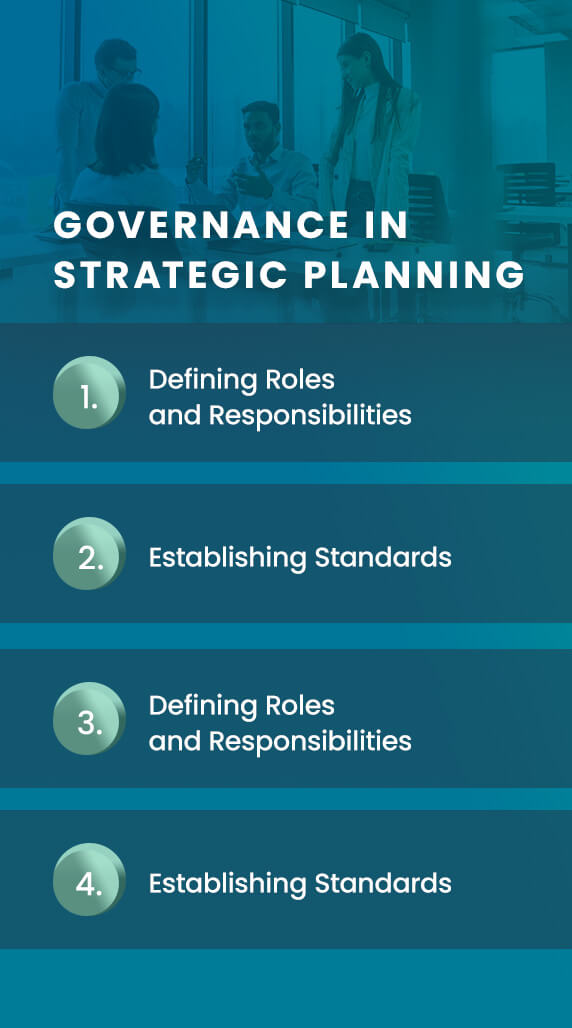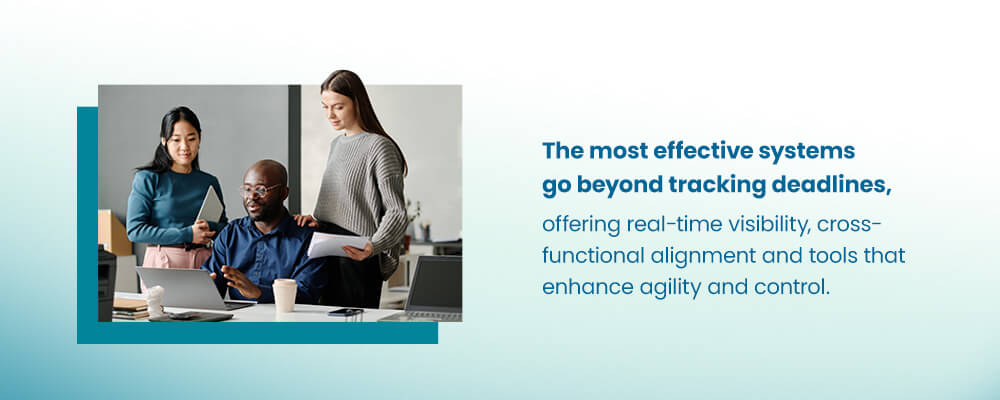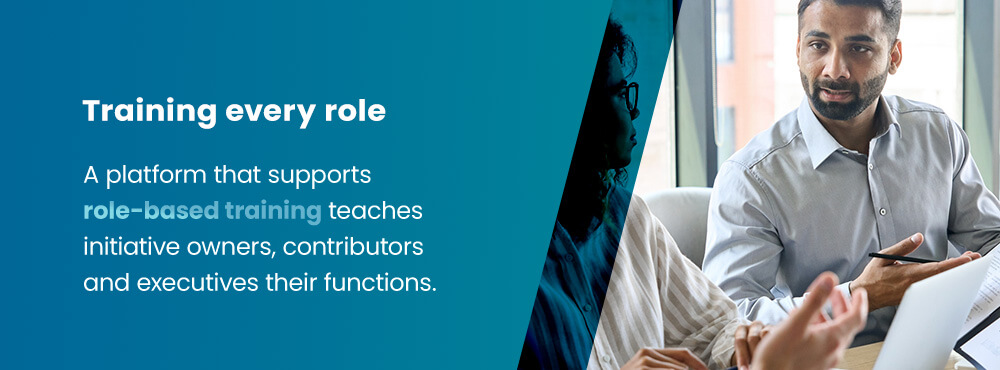With remote teams, sprawling initiative portfolios and constant pressure to deliver results, today’s chief strategy officers have more on their plates than ever. That’s why they rely on enterprise strategy execution platforms — purpose-built tools that offer the governance, visibility and control needed to manage every plan, priority and portfolio. Effective CSOs need robust solutions that are specific to their organization’s goals and agile enough to evolve with them.
In This Article
- The Importance of the CSO Technology Stack
- What Makes Chief Strategy Officer Tools Different?
- Governance in Strategic Planning
- Visibility in Strategy Execution
- Planning and Risk Management
- Automated Reporting for Strategy Leaders
- Valuable Strategic Portfolio Management Software Features for CSOs
- Implementation That Sticks
- Analytics and Measurement
The Importance of the CSO Technology Stack
CSOs’ responsibilities have evolved beyond strategic planning sessions and quarterly updates. They are responsible for connecting vision to execution. Every department and strategy must align with the organization’s goals. Without these tools, CSOs must manage everything by hand.
Many organizations still rely on spreadsheets and stand-alone project tools. While these may be sufficient for individual tasks, they lack the governance and integration CSOs need to succeed. Strategy doesn’t fail because people aren’t busy — it falls short when leaders lack the real-time insight they need to make adjustments.
Strategic planning software fills the gap. Instead of juggling multiple disconnected systems, CSOs have a single solution that consolidates updates, automates reporting and provides context across their initiatives. This streamlined tech stack eliminates redundancies and silos, so CSOs have the relevant information when they need it.
A tech stack doesn’t add another layer of complications. It’s one flexible platform that delivers all the information and functionality CSOs need to execute strategy at scale.
What Makes Chief Strategy Officer Tools Different?
It’s easy to confuse project management software with strategic planning and execution platforms. Both are valuable, but they serve different purposes. Project management tools focus on deliverables like timelines and budgets. An enterprise strategy execution platform supports a CSO’s broader roles, aligning initiatives with organizational goals and allocating resources to the correct priorities.
A department might manage dozens of projects, but the CSO determines which initiatives deserve additional investment, how they contribute to growth and when to phase them out. That’s where strategic portfolio management features come in. Platforms built for CSOs let leaders assess value and risk across programs, products, IT investments and transformation efforts. This portfolio-level perspective ensures CSOs can allocate resources effectively.
Governance in Strategic Planning
Governance keeps everyone on the same page regarding decision-making and accountability. Without standards, how do teams know who is in charge? Who reports where? Who oversees initiative success? CSOs can use tools to integrate governance into strategy execution.

1. Defining Roles and Responsibilities
Strong governance starts with standards. Make sure every initiative has defined owners, contributors and approvers. If accountability is vague, the project stalls. A strategy execution platform assigns roles, tracks updates and logs activity. Accountability becomes second nature when everyone knows who’s responsible for various tasks and there’s no guesswork about ownership.
2. Establishing Standards
Inconsistent updates put everyone on their back foot. CSOs need a platform that standardizes schedules so leadership is never in the dark. Instead of chasing information across email chains, CSOs give leaders confidence in their work. Teams can see accurate, updated information and know they’re on the right track.
3. Improving Flexibility
Organizations use different planning methods, so effective governance in strategic planning shouldn’t lock leaders into one format. Instead, the CSO’s tech stack should accommodate multiple structures while maintaining reporting consistency. Teams follow established processes while keeping governance in place.
4. Maintaining Oversight
Finally, governance is synonymous with oversight. Platforms must provide permissions and change logs to protect data. These features can prevent errors and highlight who made what updates and when. CSOs can instantly provide records to upper leadership, improving organizational trust. Strategy execution becomes transparent and accountable when CSOs embed governance into their tools.
Visibility in Strategy Execution
Even the best strategy can unravel if leaders lack real-time visibility. For CSOs, staying ahead means tracking progress and spotting risks before they escalate. Without that clarity, organizations shift from proactive to reactive — addressing problems only after they’ve disrupted the plan. A strategy execution platform brings transparency to every initiative, integrating seamlessly with existing workflows to keep leadership informed and momentum intact.
1. Multi-View Planning
Executives and managers need tailored perspectives to stay aligned. Enterprise strategy platforms offer flexible, multilayered views so stakeholders can access information in their preferred format. Whether you zoom out to monitor progress or drill into specific initiatives, everything lives in one unified system for maximum clarity and control.
2. Dependency Mapping
Mishandled dependencies can lead to setbacks. A single missed handoff may ripple across portfolios, delaying the entire timeline. Platforms that include dependency mapping in project management make these connections unmistakable. Teams can easily see how one delay might impact other areas. CSOs can view the timeline and actively intervene before issues escalate.
3. Real-Time Dashboards
Quarterly reports are too slow for the modern age. CSOs need dashboards that update as soon as teams provide input. These dashboards display key performance indicators and offer information on performance and progress. Trend lines, variance flags and heatmaps transform static data into actionable insights.
4. Cross-Portfolio Rollups
Large organizations must integrate hundreds of plans. Rollup reporting lets CSOs evaluate progress by department, geography or initiative type. Viewing progress through these filters helps leaders get a better perspective on their progress. Instead of becoming frustrated by isolated activity, they see how organizational efforts support the strategy.
Planning and Risk Management
Governance provides structure, and visibility delivers insights, but CSOs need control to manage strategy in real time. Planning and risk management need control so CSOs can adjust as conditions change. Modern risk management tools for CSOs let leaders adapt while staying on track.
Scenario Planning
Strategic execution is about choices. CSOs must decide which projects to fund and which to retire. Leaders can model scenarios with integrated portfolio views. What happens if resources shift to another area? How does pausing one project free up room elsewhere? These insights let CSOs make data-driven decisions to protect their long-term success.
Risk Management Tools
Every initiative comes with risk. However, you can avoid budget overruns and missed deadlines with a tracking and escalation framework. Platforms designed for CSOs include risk tracking and alerts. Tools can flag faltering initiatives before they derail everything. CSOs proactively step in and steer the ship into safe harbor.
Cascading Change
Traditionally, strategy leaders responded to changes by updating dozens of manual reports. A support platform eliminates this by cascading changes automatically. Dashboards instantly reflect status updates, keeping stakeholders working from the same current information.
Automated Reporting for Strategy Leaders
Even if you’ve got the strategy handled, an endless cycle of manual reporting can slow down processes. Reconciling spreadsheets and consolidating progress emails is a waste of valuable time. Modern platforms solve this problem by embedding automation into the CSO technology stack. Leaders can focus on making better decisions instead of collecting data.
Automated reporting gives strategy leaders direct updates into dashboards and report packets. They can tailor reports to the audience and schedule without manually entering each. Automated tools can also ensure stakeholders receive the current, accurate data they need to do their jobs.
Streamlined Update Collection
Automation also simplifies progress reporting. Instead of sending reminder emails or hosting status calls, the platform prompts initiative owners to provide regular progress briefs. Log, contextualize and roll up information with a click. Faster, easier collection equates to quicker and better data delivery. Plus, you reinforce accountability without adding red tape.
Early Insights and Alerts
Automation saves time and provides insights sooner. Platforms can flag variances against KPIs, highlight missed milestones and send alerts when projects fall behind. CSOs receive early notifications to intervene before issues escalate, thus streamlining strategy execution.
Valuable Strategic Portfolio Management Software Features for CSOs

Beyond timeline management, CSOs need an organization-wide platform that connects ideas to action. The most effective systems go beyond tracking deadlines, offering real-time visibility, cross-functional alignment and tools that enhance agility and control. Take strategy out of the slide deck and implement it at every level.
- Portfolio scoring: Not all initiatives are equal. Platforms should let CSOs score and prioritize projects based on value and risk to resources flowing toward initiatives with maximum long-term impact.
- Resource views: A plan needs resources. Software shows headcount, budgets, skills and timing so leaders understand capacity constraints before they become bottlenecks.
- Dependency mapping: Complex strategies often involve dozens of interdependent initiatives. Find solutions with dependency mapping to make all these connections visible. You’ll prevent surprises and keep timelines realistic.
- Performance tracking: Effective execution relies on results, too. CSOs need dashboards that connect progress to KPIs and benefits realized. Real-time reporting makes it evident whether teams meet objectives or need adjustment.
- Integration hub: Most enterprises rely on financial, HR and project tools. Advanced platforms can be an integration hub that syncs data across systems, prevents data siloes and ensures everyone works from the same information.
- Security controls: Look for solutions with governance features like enterprise-grade security and governance.
Managing Ambiguity
Innovation leads to long-term growth that is often less structured and defined. CSOs regularly deal with predictions, forecasts and uncertain returns on investment. Even if your current initiatives are vague, you can easily manage them with the right tools.
Traditional reporting focuses on deadlines, budgets and output. Creativity doesn’t always fit neatly into these boxes. Pilot programs or experiential processes could take multiple cycles to show value. If you judge them by the same metrics as core operations, you might deprioritize them too early.
Building a Flexible Framework
Your strategy execution platform should let leaders handle innovations alongside core projects. Instead of focusing solely on ROI, platforms can track validated learning or adoption signals. A flexible platform lets innovations progress without unfair judgment. Plus, managing everything on one platform gives you a complete view of resource management across short-term and long-term timelines. Teams can see the bigger picture and chip in when necessary.
Implementation That Sticks
Even the most advanced platform won’t deliver results if misused. CSOs must emphasize adoption, training and cultural alignment or ensure buy-in. Effectively implementing your tech stack involves several steps.
- Promote from Day One: CSOs must appoint leaders in every department and communicate the “why” behind the change. What are the participation expectations? When employees understand how the platform improves execution, adoption rises.
- Training every role: Governance needs everyone to fulfill specific responsibilities. A platform that supports role-based training teaches initiative owners, contributors and executives their functions. This approach ensures the appropriate person completes all updates and reports.

- Stay flexible: Since organizations use different planning styles, implementation should be flexible. Using platforms that adapt to team methods reduces disruption.
- Continuously improve: Implementation never ends. CSOs must set schedules for reviewing dashboards, auditing update quality and refining workflows. These feedback loops keep the system aligned with the strategy even as conditions change.
Analytics and Measurement
Analytics is the final component of CSO tech stacks. Combining measurements and analytics eliminates guesswork in favor of evidence-based leadership. Use CSO-focused platforms to track adoption, performance and outcomes so you can adjust strategy in real time.
- Tracking adoption and engagement: Are teams using the system? Metrics like update completion rates, timeliness and data quality identify gaps that can show you where to focus your energy.
- Monitoring execution indicators: CSOs must track progress by evaluating milestone completion rates. Watch these signals and proactively ensure initiatives run smoothly, instead of waiting for problems to halt progress.
- Measuring outcomes and impact: Execution is equal parts activity and results. Connecting initiatives to your desired KPIs lets you demonstrate whether strategic objectives deliver tangible impact.
- Automating reporting: Use a tool that puts performance data directly into role-based dashboards and scheduled updates — giving executives and managers instant access to the information they need.
Reach Your Full Potential With AchieveIt

Say goodbye to spreadsheets and siloed tools and embrace a single platform built for enterprise strategy execution. With AchieveIt, you get flexible plan structures, automated reporting and cross-portfolio visibility in one system. We help you spend less time chasing updates and more time driving outcomes.
A partnership approach sets AchieveIt apart. Alongside powerful software, every engagement includes experts who help configure your plans and streamline execution rhythms. Equip your team with the confidence to execute strategy at scale. Request a demo today.



